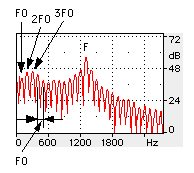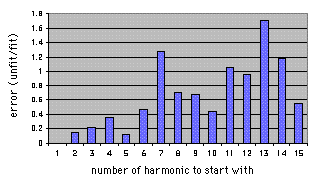Acoustical Society of America
136th Meeting Lay Language Papers



MUSICAL SCALES IN XOOMIJ
Yuki Kakita- kakita@mattolab.kanazawa-it.ac.jpDepartment of Human Information Science
Kanazawa Institute of Technology (KIT)
Oogigaoka 7-1,Nonoichi-Machi, Kanazawa-Minami 921-8501, Japan
Contact Information During ASA Meeting:
Contacting by E-mail is preferred.
kakita@mattolab.kanazawa-it.ac.jp
(regularly checked during meeting)
The author is staying at Norfolk Waterside Marriott Hotel /Tel.: 757-627-4200
or 800-831-4004/Fax: 757-628-6452
Popular version of paper 2pMU8
Presented Tuesday Afternoon, October 13, 1998
136th ASA Meeting, Norfolk, VA
Summary
This paper proposes that there exists the most appropriate musical scale in Xoomij when we consider the basic theory of both the sound structure and the musical scale. First, I will present the simple modeling of sound structure of Xoomij. Then, about the basic structure of the musical scale of Xoomij.What is Xoomij?
Xoomij is a type of singing performed in Mongolia and in some other parts of the Eurasian continent. Xoomij is also spelled as "Khoomei", and is more generally called "overtone singing" or more simply "throat singing".Exhibit 1 demonstrates an example of Xoomij singing, for those who are
not familiar with the sound. The sound is taken from a music CD (1).
| xoomij real |
| Exhibit 1 Real example of Xoomij |
As you can hear, a high tone changes its pitch to play a tune, while at the same time, there is an accompanying low stable tone. The frequency of the low tone is about 100-200 Hz, and the frequency of the high tone is about1000-2000Hz.
Now, I will compare the spectral structures of the vowel and the Xoomij sound.
Exhibit 2 shows the frequency components of the vowel /a/, and Exhibit
3 shows the model representation of the frequency components of Xoomij.
Both were calculated by a speech synthesis software. The abscissa is frequency,
and the coordinate is the amplitude in dB.

Exhibit 2 Spectral characteristics of vowel /a/. F indicates formant. F0=120Hz. For simplicity, this vowel is synthesized by a speech synthesis software. |

Exhibit 3 Spectral characteristics of a Xoomij sound calculated by the single-formant (band-pass filter) model. F indicates formant. |
The leftmost sharp peak indicates the voice pitch, or the fundamental frequency, F0. The other peaks are the harmonics. The harmonics are defined as F0 multiplied by an integer, yielding 2F0, 3F0, and so on. The harmonics are evenly spaced in the spectrum, and consequently any consecutive pair of harmonics are separated by the value of F0.
The three dull peaks labeled F1, F2, F3, in Exhibit 2, are called formants.
The combination of formants determines the kind of vowel. Each formant
represents a resonance caused by a cavity in the speech organ. In speech
science, the frequency characteristics of a formant is approximated by
an audio band-pass filter. Since a single high tone plays the tune in Xoomij,
it is natural, as a first approximation, to use a single band-pass filter
to demonstrate the Xoomij sound.
As I will explain later, the fact that the frequency components of
the voice are evenly spaced has a crucial influence on the construction
of the Xoomij musical scale.
To check if the single-formant (or single-filter) model works, an example
of synthetic Xoomij sound was produced using a speech synthesis software.
(Exhibit 4b) The original sample shown in Exhibit 4a, performed by a human,
is the same as that shown in Exhibit 1.

Exhibit 4a Real Xoomij tune
|

Exhibit 4b Synthesized Xoomij tune
|
Based on a single-formant model, an example of Xoomij tune was synthesized. Exhibit 4b shows its sound spectrogram.
Exhibit 4a shows the sound spectrogram of the original Xoomij tune, which was performed by a human.
What I want to demonstrate here is that the single-format model is adequate
for simulating Xoomij sounds.
Exhibit 5 shows the sound spectrograms of five series of synthesized Xoomij sounds. I would like to show how the difference in the F0 value affects our perception of the Xoomij musical scale.
The F0 values are, from left to right, 100, 150, 200, 250, and 300 Hz. In each series of sounds, the center frequency of the band-pass filter is linearly increased from 300 Hz to 3000 Hz, then linearly decreased to 300Hz.
The higher the F0, the greater the interval of the two consecutive notes,
and as a result, we perceive different musical scales.
 |
|
|
|
|
|
|
There are two factors which influence the musical scale in Xoomij, one is the linear nature of harmonics of the voice, and the other is the selection of the harmonic with which to start the musical scale. The harmonic frequency components of voice are equally spaced in linear frequency. In contrast, musical interval is equally spaced in logarithmic frequency. In music, generally, the scale is determined by the frequency of each constituent note relative to the base note, and so the absolute frequency value does not matter.
Now, in Xoomij, too, the scale is determined relatively. However, since
the consituent note must be selected from the harmonics of voice pitch,
the musical scale in Xoomij is determined by the harmonic that the scale
starts with.
Calculations were performed to see what musical scales would be realized when the scale started with each of the 1st to 30th harmonics of voice.
Goodness of fit was obtained by examining if the n-th voice harmonic
fits a musical note within the error range of plus/minus a quarter semitone.
The frequency range examined was from -1 to +2 octave from a practical
point of view.

|
In Exhibit 6, the abscissa indicates the number of harmonic with which the scale starts, and the ordinate indicates the unfit/fit error rate.
As a result, the unfit/fit error rate was the lowest when the scale started with the 5th harmonic. So, thoeoretically this can be said to be the most appropriate scale in Xoomij.
The scale starting with the 5th harmonic is shown in this figure. The
scale starting with the 5th harmonic is " do #re #fa #so #la do2 --- #re2
--- #fa2 so2 #so2 la2 #la2 si2 do3" when the base is selected as "do".

Exhibit 7 Scale starting with the 5th harmonic. 1-4th harmonic
are in ( ) and are not shown. The symbol " |
Although the scale starting with the 5th harmonic is theoretically the most appropriate, the examination of the sound data of actual Xoomij performances indicates that the most frequently used scale is the scale starting with the 4th harmonic.
The scale starting with the 4th harmonic is shown in this figure. The
scale starting with the 4th harmonic is "do mi so --- do2 re2 mi2 --- so2
--- --- si2 do3"

Exhibit 8 Scale starting with the 4th harmonic. 1-3rd harmonic
are in ( ) and are not shown. The symbol " |
Why performers prefer the scale starting with the 4th harmonic is left
for future studies. One possible reason is that the sounds in the high
frequency region in the scale starting with the 5th harmonic is difficult
to produce, because it needs a very fine adjustment of the size of a small
cavity.
(1) Portion (8s) taken from 13-SYGYT of the CD (Huun-Huur-Tu: The Orphan's Lament, SHANACHIE 64058).
*After this meeting the author will start his sabbatical stay at Ohio
State Univiersity till March 31, 1999.
Address: c/o Professor Osamu Fujimura, Department of Speech and Hearing
Science, Ohio State University, Pressey Hall Room 103, 1070 Carmack Rd.,
Columbus OH 43210-1002
E-mail: kakita@mattolab.kanazawa-it.ac.jp